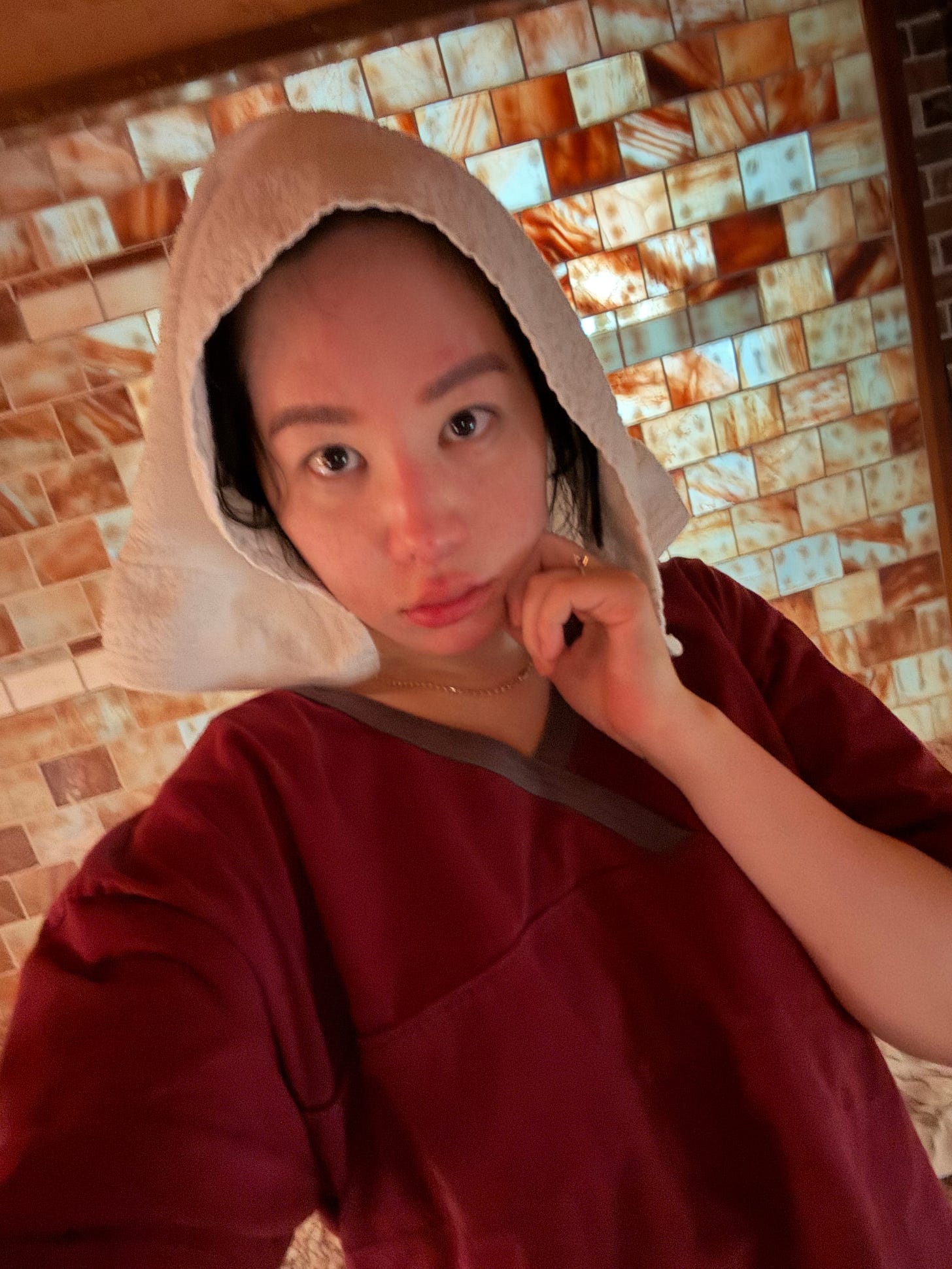Kicking off WoW content below the paywall but first a travel spa bag
WIYSB with
Gia is a NYC-based PR maven whom I’ve had the pleasure of knowing for years and working on brands like Luar and AREA. When she comes to LA, shes a Crystal Spa gal - the last time I saw her at a Kiko LA function, I could tell she was at Crystal pre-event by the smell of her hair. She’s been bopping around European lakes and seasides, making for a perfect What’s In Your Spa Bag Travel feature.
In my spa/travel bag are:
Hair Mask: Shiseido Fino Premium Hair Mask
Hair Oil: Currently enjoying the Kiiks Green Tea Seed Hair Oil
Body Scrub: those cheap Korean square scrubs cloths you can get on Amazon but works wonders especially after a steam
Mud Mask: post-steam pore extraction mask I am currently using Round Lab 1205 Dokdo Mud Pack
Sheet Mask: Medicube PDRN Pink Collagen Gel Mask
Eye Steam Mask (more for travel): love the Japanese KAO MegRhthym Steam Masks for travel and sleep - in diff scents
Body Oil: Aesop A Rose By Any Other Name oil is my lux version otherwise
Face Moisturizer: Skinceuticals CE Ferulic as base
Sunscreen: If I go to the spa during the day, I'm definitely leaving with SPF on, and my favorite is the Cell Fusion C Laser Sunscreen SPF 50+ that is made for sensitive skin
A great hair clip and a detangle brush...
Thanks Gia <3333
˚₊‧ ଳ ‧₊˚ ⋅⋅˚₊‧ ଳ ‧₊˚ ⋅⋅˚₊‧ ଳ ‧₊˚ ⋅⋅˚₊‧ ଳ ‧₊˚ ⋅⋅˚₊‧ ଳ ‧₊˚ ⋅⋅˚₊‧ ଳ ‧₊˚ ⋅⋅˚₊‧ ଳ ‧₊˚ ⋅⋅˚₊‧ ଳ ‧₊˚
After Kraków we headed down to the very bottom of Poland, where the mountain ranges become the natural divider between Poland and Slovakia. Along the way, we had to stop for history along the way. In the 1200s, Hungary was Europe’s top salt mining country AND it just so happens to be where Princess Kinga, who later became a Polish saint, was from.
Legend has it that Princess Kinga threw her engagement ring into a salt mine in Hungary, and it somehow traveled through the earth to Poland. When miners in Wieliczka Salt Mines found the ring, they also discovered rich salt deposits, which brought wealth to the region. In her honor, they built a statue of Saint Kinga. Salt was extremely valuable, not only because of its flavour-enhancing capabilities but also due to its necessity as a staple in food preservation, making the mine a major economic boost for Poland. (It's also said she and her husband took a vow of chastity and were known for their charity work in Poland)
Salt, mere sodium chloride, is one of the most gorgeous minerals with us on this earth. I say this because salt transforms, piecing itself out to us for various needs and chemical compound changes. Salt preserves, it heals us, cleans, floats us… you get the idea, it’s important - and actually essential - for living.
So the salt caves were on our radar, but we did not know what we were going to find. We climbed down more than 800 stairs into the heart of the Earth. Normally, I don’t get very nervous or claustrophobic, but the way that this cave is so deep and so dark and sooooo huge, I have to admit that when I thought about it, it freaked me out. Our tour guide, Matthias, was the star of the show. It was a two-hour-long walk all through the different underground chambers complete with salt-carved scenes of miners pastimes, including banquet halls, wells, salt brine lakes, and even a church. You can see the salt growing in streaks, almost like a fungus, with the colors visually differentiating between the pure crystals and rock salts “contaminated” with other minerals found in the Earth.
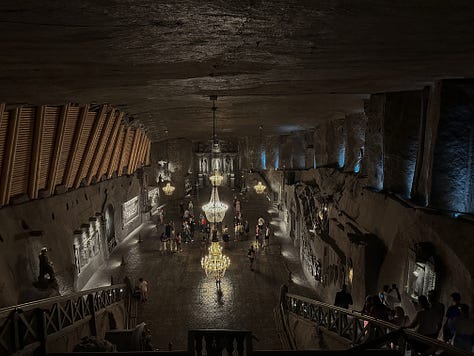
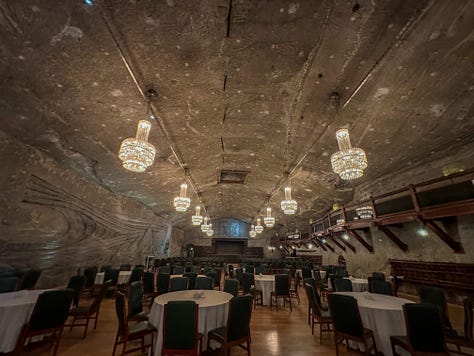
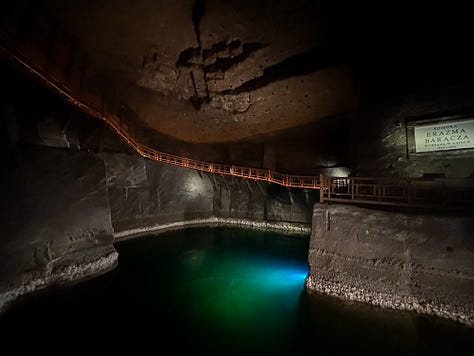
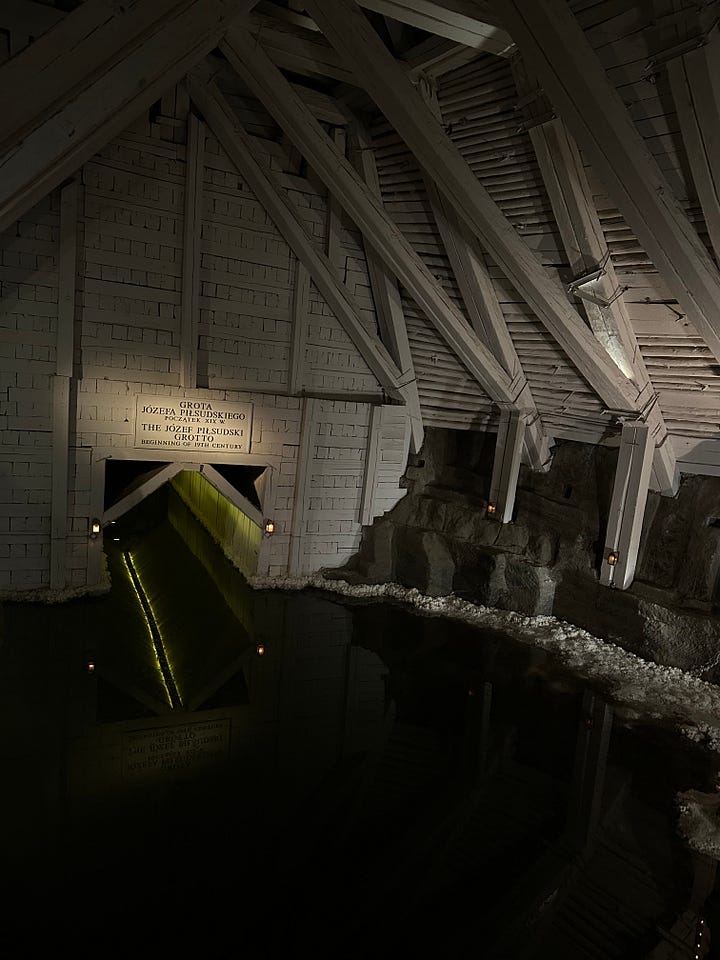

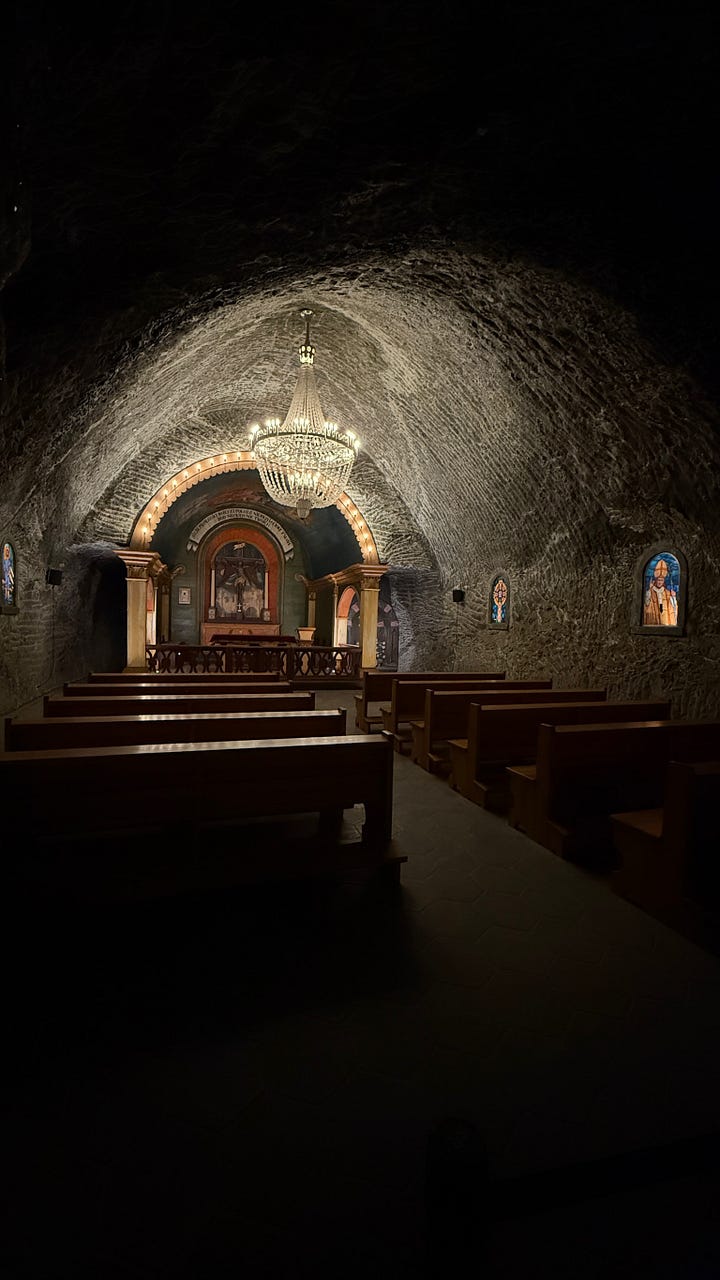
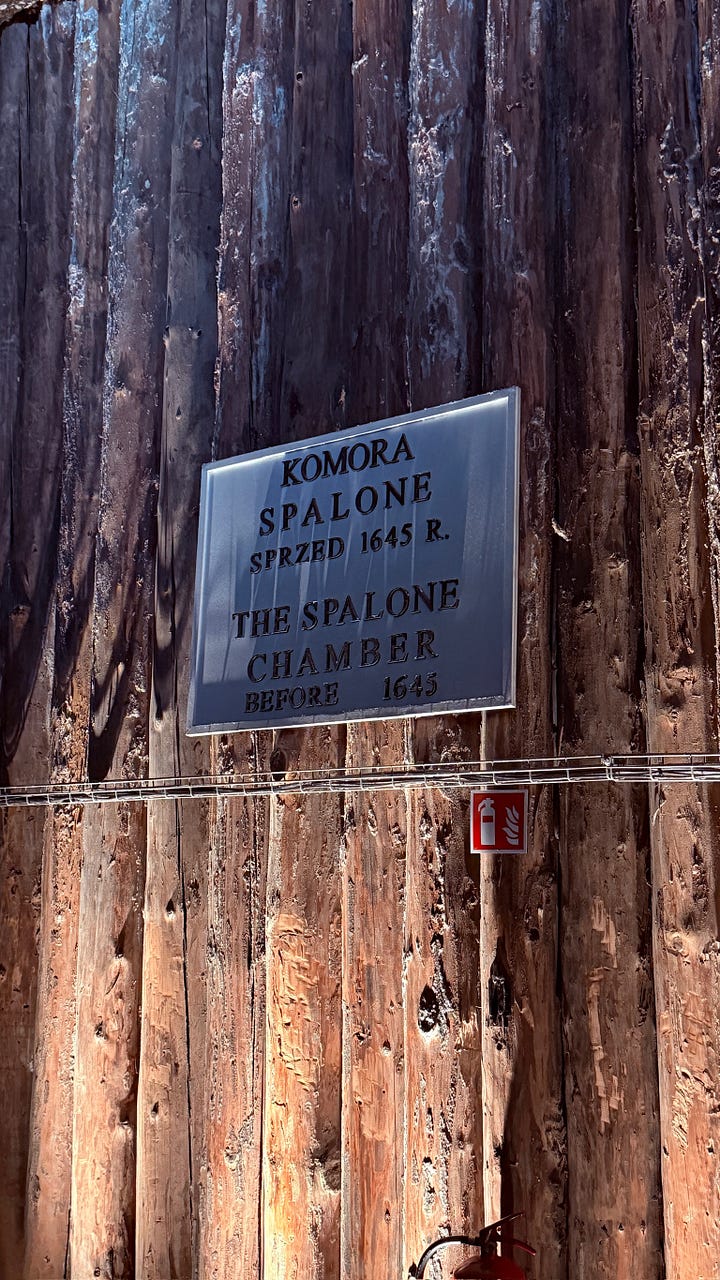
What I’m very upset about, and I didn’t know before visiting, is that there is an underground salt spa. You’ve probably been to a Korean spa with a salt sauna room or maybe the Himalayan salt cave in Santa Barbara. The practice of Halotherapy is breathing in salty air. This practice literally came from the salt miners in Poland and Eastern Europe from the 1880s because they did not get nearly as many respiratory diseases and were unusually healthy compared to the rest of the population at that time, but especially coal miners. Salt in the air keeps the lungs free from infection and allergies. These Eastern European salt mines and caves became popular tourist destinations for spa treatments.
According to the websites, the partnership between the Grand Sal Hotel and the mines function together so wellness guests can stay either underground completely or above ground with access to the mines to breathe in salt air for up to 21 DAYS. Fancy planning a company corporate retreat staying down below? OR I implore you to consider getting married underground if halotherapy is your thing.
Here are some stats of the microclimate: The temperature stays around 14°C, the air humidity sits between 60 and 75% humidity, and there are roughly 3-8 mg per nanometer of sodium chloride content in the air.
They have therapeutic treatments, including massage and gentle stretching, medical consultations for allergy and lung clinics, and they can run diagnostics, including different types of respiratory, heart, blood, and allergy tests with the onsite doctors
For 220 zl (~60USD) you get to visit the underground health resort in daytime mode for 5 hours, where you get to participate in breathing exercises, aerobics, stationary exercise, all the while breathing the salt air and touring the mines at almost half a mile underground.
If we weren’t on the move, I would have opted to spend the night in what used to be horse stables for the animals that worked in the mines deep inside the caves. The program they call healthy sleep is available for 195 zl a night, less deep at 135 meters underground. (Maybe Logan and I need to double back to Krakow next week… let me know if you think we should)
They also host family courses, meditation, and dedicated days that they call depths of consciousness, and breathing in sport.

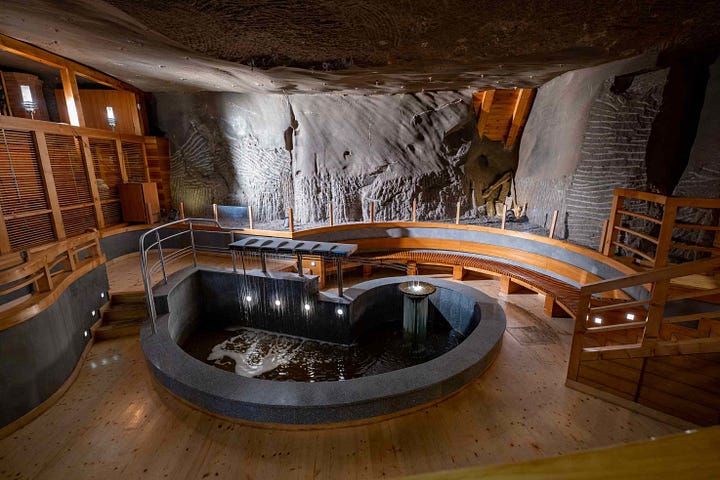
From their website
Research on the beneficial influence of the salt underground microclimate on the functioning of the human respiratory system was first carried out by Dr Feliks Boczkowski. He noticed that Wieliczka miners were much less likely to develop lung diseases, a typical ailment of coal miners. It was on Boczkowski’s initiative that a bathing establishment was established in Wieliczka (1839), which offered saline baths, salt mud baths and inhalations.
The second figure important for the health resort of Wieliczka, was Dr Mieczysław Skulimowski. As a mine physician, he initiated treatment using the beneficial properties of the salt climate of the underground. In this way, he laid the foundations for a new method of treatment of respiratory diseases – subterraneotherapy. It was Dr Mieczysław Skulimowski who contributed to the establishment of the first underground sanatorium in Poland (the second in the world) in 1958.
Since 2011, by decision of the Minister of Health, the “Wieliczka” Salt Mine Health Resort is the only underground health resort in Poland. In addition to therapeutic programmes, it also offers recreational programmes, thus becoming a part of the spa tourism trend.
Writing this up has me convincing myself that I actually need to experience the underground salt spa area, but the 3-hour tour with a stop at the gift shop will have to suffice for now.
Next, we’re on to Zakopane - Poland’s answer to the Swiss/Austrian alps
xoxo,
Coco




